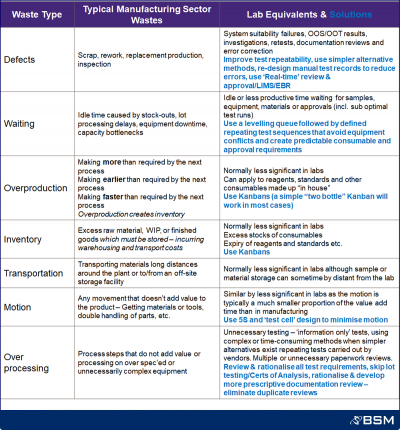Waste in Laboratories
Laboratories are not the same as manufacturing environments so do the standard Lean ‘Wastes’ even apply in Labs?
The term ‘Lean’ was first coined in 1990 to describe the manufacturing approach being used in Toyota factories in Japan. The “Toyota Production System” (or TPS) as it was called locally had been developed mostly by Taichii Ohno a mechanical engineer who rose through the ranks to become Executive Vice-president.
TPS shifted the focus of improvement initiatives from individual machines and their utilisation, to the flow of the product through the total process. Toyota understood that they could create ‘flow’ and reduce waste by lining their machines up in process sequence, developing quick set-ups (so that each machine could make small volumes of many part numbers) and by having each process step notify the previous step of its current needs for materials (i.e. pull). This in turn made it possible to achieve low cost, high quality, and rapid throughput times with high product variety.
“Add Nothing But Value” (Eliminate Waste)
In developing the Toyota Production System, Ohno identified 3 primary wastes - Mura, Muri and Muda in Japanese and seven (now famous) sub categories of Muda. Elimination of these wastes is the basis of most lean projects but are they relevant in the Lab environment?
Mura
Mura (unevenness) is the waste associated with volitile workloads. If anything, Mura is even more significant in Labs than in traditional manufacturing. In most labs there is short term volatility in the incoming workload with significant peaks and troughs. More often than not, this volatility is imported directly into the testing process which causes low productivity (during troughs) and poor lead time performance (during peaks). Levelling a volatile workload is perhaps the single most valuable thing that can be done when leaning a lab.
The simplest levelling strategy is to create the ability to process samples at the 'levelled demand rate' quickly (via flow). This reduces the 'throughput' time and incoming samples can then be held in a 'levelling queue' at the start of the process and released into the lab as part of a level daily volume and mix.
Muri
Muri (overburden) is the over loading of people or equipment. In Ohno’s world this included physical strain. In Labs a form of Muri is often directly caused by Mura when analysts are overloaded in an attempt to deal with peaks in the workload. ‘Muri’ can be avoided via levelling and defined analyst roles based on a repeating sequence of testing that meets levelled demand. It can be done!
Muda
Muda (waste) – Muda is any activity that doesn't add value (as defined by the customer). Ohno defined 7 forms of Muda and while most of these can be found in Labs, individual wastes may not be as significant in a Lab context as they are in manufacturing.
A cautionary note: The significance of Mura and Muri is often misunderstood and underestimated and many Lean Lab projects focus only on the Muda. There is a simple reason for this, waste is easy see and understand and tools like Value Stream Mapping help identify lots of new wastes to work on. Whereas tackling Mura and Muri is much more challenging particularly in Labs.
Eliminating waste from a levelled flowed lab process, instead of at isolated points creates processes that need less human effort, less space, and less time to test samples at less cost and with fewer errors and test failures, than traditional labs. Lean labs are also able to respond to changing customer priorities with fast throughput times.
Our consultants can provide further information on the above and discuss any aspect of Real Lean Transformation, simply set-up a call today.


